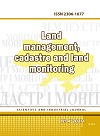Optimization of the agricultural land structure as the basis of sustainable development of rural areas
DOI:
https://doi.org/10.31548/zemleustriy2019.04.01Abstract
The modern structure of agricultural lands, formed in the conditions of a radical reformation of land relations in rural areas, is analyzed. It is revealed that this structure in agricultural enterprises of different forms of ownership does not meet the principles of rational use of nature due to the excessive share of arable land and low - environmentally sustainable land. At the same time, the share of the arable land in the structure of agricultural land in the non-state agricultural enterprises is 11-12% higher than in the state-owned, which is explained by the efforts of private entrepreneurs – tenants aimed at increasing agricultural production by expanding the area of arable land. The extremely high level of plowing of agricultural land is a consequence of the extensive use of land resources and the main reason for the spread of degradation processes. The only solution to this problem is the development of land management projects that provide ecological and economic justification for crop rotation and land management.
It is shown that the sustainable development of rural territories is not possible without improvement of the structure of sown areas, the main current disadvantage of which is the market-driven excessive share of highly profitable crops of the technical group and a very low share of forage crops, which can be the cause not only of the ecological but also of the socio-economic problems. Optimization of the structure of the sown areas of crops should be carried out on the basis of ecological-landscape land management in consideration with the soil and climatic conditions of specific rural territories and resource provision of agricultural enterprises.
Key words: agricultural land, structure of cultivation ares, agrarian enterprises, organization of territory, crop rotation.
References
Dorosh O.S. Metodolohichni zasady okhorony zemel v Ukraini. Zemlevporiadnyi visnyk. - 2012. - № 8. - S. 19-23. Rezhym dostupu: http://nbuv.gov.ua/UJRN/Zv_2012_8_6
Dorosh O.S. Rol sotsialno-ekonomichnoi y instytutsiinoi skladovykh u formuvanni y funktsionuvanni ahrokholdynhiv v Ukraini. O.S. Dorosh, I.P. Kupriianchyk. Zemleustrii, kadastr i monitorynh zemel. - 2016. - № 3. - S. 12-19. DOI: http://dx.doi.org/10.31548/zemleustriy2016.03.012
https://doi.org/10.31548/zemleustriy2016.03.012
Zakon Ukrainy «Pro zemleustrii» vid 22 travnia 2003 roku za №858-IV Zemelne zakonodavstvo Ukrainy: Zbirnyk normatyvno-pravovykh aktiv. - Kyiv: Istyna, 2007. - S.134-157.
Zemelnyi kodeks Ukrainy vid 25 zhovtnia 2001 roku za №1389-XIV //Ofitsiinyi visnyk Ukrainy.- 2001.- № 46.- S.20-38.
Kysel V.Y. Byolohycheskoe zemledelye v Ukrayne: problemы y perspektyvы /V.Y.Kysel.-Kharkov: Shtrykh, 2000.-162s.
Klasyfikatsiia silskohospodarskykh zemel yak naukova peredumova yikh ekolohobezpechnoho vykorystannia /D.S.Dobriak, O.P.Kanash, D.I.Banbidra, I.A.Rozumnyi. - [2-he vyd., dop.]. - K.: Urozhai, 2009. - 464s.
Pimenova O.V. Model otsinky efektyvnosti form hospodariuvannia v ahrarnomu sektori. O.V.Pimenova. Ekonomika i prohnozuvannia.-2012.-№4. - S. 63-72.
Silske hospodarstvo Ukrainy: statystychnyi zbirnyk za 2018 rik. -Kyiv: Derzhavna sluzhba statystyky Ukrainy, 2019. Rezhym dostupu: http://www.ukrstat.gov.ua/
Gray R., Paddock B., 1993 Land Set Aside: Is it Food Security? Canadian Journal of Agricultural Economics. -1993.-Vol.41.-N4.-P.441-451.
https://doi.org/10.1111/j.1744-7976.1993.tb03769.x
Statistical Abstract of the United States: 2012-2013. The National Data Book. Washington: U.S. Department of Commerce, 2013. 540 s.
Downloads
Additional Files
Published
Issue
Section
License
Relationship between right holders and users shall be governed by the terms of the license Creative Commons Attribution – non-commercial – Distribution On Same Conditions 4.0 international (CC BY-NC-SA 4.0):https://creativecommons.org/licenses/by-nc-sa/4.0/deed.uk
Authors who publish with this journal agree to the following terms:
- Authors retain copyright and grant the journal right of first publication with the work simultaneously licensed under a Creative Commons Attribution License that allows others to share the work with an acknowledgement of the work's authorship and initial publication in this journal.
- Authors are able to enter into separate, additional contractual arrangements for the non-exclusive distribution of the journal's published version of the work (e.g., post it to an institutional repository or publish it in a book), with an acknowledgement of its initial publication in this journal.
- Authors are permitted and encouraged to post their work online (e.g., in institutional repositories or on their website) prior to and during the submission process, as it can lead to productive exchanges, as well as earlier and greater citation of published work (See The Effect of Open Access).


